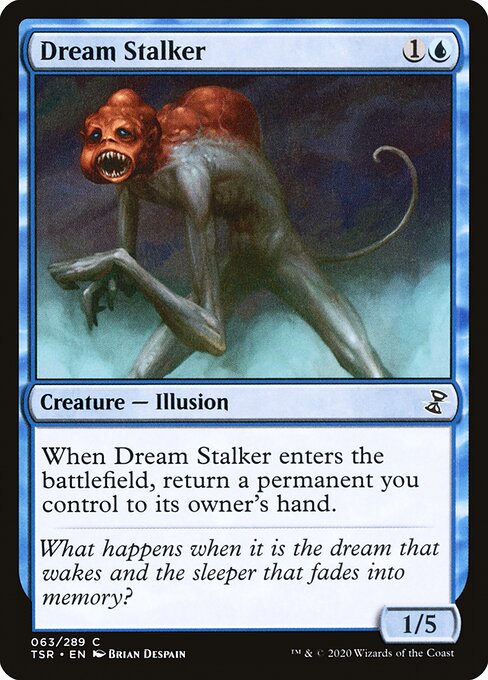
Image courtesy of Scryfall.com
Composition as Narrative Engine in Dream Stalker
In Magic: The Gathering, every card isn’t merely a line of rules text; it’s a cue, a moment in a bigger story you weave across a match. Dream Stalker embodies that idea with a quiet yet potent design that leans into the artistry of composition. For {1}{U}—a lean two-mana investment—you get a 1/5 Illusion that arrives with a scene-stealing line of ETB text: “When this creature enters, return a permanent you control to its owner's hand.” The statement unfurls ahead of your next turn like a whispered preview of the play you’re about to script. The card’s very presence asks you to choreograph the battlefield, not just brute-force it 🧙🔥💎.
That line of text reframes tempo and space on the battlefield. You’re not simply deploying a threat; you’re rewriting the piece of the board you’ve already set. Which permanent will you retrieve from your own grip—an important creature you want to replay with a cheaper cost, a mana-rock you plan to recast after a big mana spike, or a crucial permanent that you want to disrupt from your opponent’s plan by returning it to your hand firsthand? The choice is narrative gold: it creates a deliberate pause, a moment of storytelling as you plan your next scripted beat, and your foe must react to a scene that can shift in a heartbeat 🧙♂️⚔️.
The flavor text—“What happens when it is the dream that wakes and the sleeper that fades into memory?”—reads like a question for the table, inviting everyone to imagine the dream’s consequences and the sleeper’s fate. It’s a reminder that blue’s storytelling strength isn’t just in drawing cards; it’s in shaping what remains after a moment of magic resolves. Dream Stalker’s ability invites you to sculpt outcomes, to decide which memories come back to life as you ride the current of the game’s narrative. The artwork by Brian Despain further anchors that mood, a dream-world portrait that feels just out of reach—like a memory you’re almost ready to recall, if only for a moment 🖼️🎨.
“What happens when it is the dream that wakes and the sleeper that fades into memory?”
The card’s art and flavor are a compact micro-epic: blue magic as memory-work, a temporary reordering of time, and the quiet thrill of giving your own plans a second chance while the dream lingers. In Time Spiral Remastered, that memory-twined vibe is part of a broader tapestry that rewards players who savor the storytelling potential of each play. Dream Stalker doesn’t shout for attention; it nudges you toward a moment where strategy and tale-telling intersect, and your table leans in to hear the next line of your saga 🧙🔥.
Practical Deckbuilding: Using Dream Stalker to Tell Your Tale
- Tempo the board: Pair Dream Stalker with low-cost spells or counterplay to tilt the momentum, then replay a key permanent from your hand to reset the scene on your terms. The reader at the table starts narrating the shifting power dynamic before you even untap.
- Blink and double-dip: With ETB shenanigans or blink effects, you can trigger multiple bounce moments, effectively rewriting the board state in a single turn and giving you a new chapter to describe as the story unfolds.
- Protect your playset: Time your cast so that you don’t expose yourself to an avalanche of removal. Let the dream linger until you’re ready to pivot, turning the next draw into a surprising twist rather than a predictable continuation 🧙♀️.
- Commander-friendly storytelling: In EDH/Commander, Dream Stalker shines as a versatile piece that supports long-form narratives, enabling you to weave memory-driven arcs across a table of diverse decks and personalities.
Beyond the table, the TSR reprint reality makes Dream Stalker accessible in both foil and non-foil forms, inviting players to add a dash of dream-draped intrigue to their decks without chasing a scarce chase rarity. The blue illusion’s quiet power offers a storytelling engine that rewards thoughtful sequencing, not just fast plays—a virtue that resonates with fans who relish narrative depth alongside efficient performance 🧠🎲.
Aesthetic, Value, and Collector’s Note
As a common rarity card, Dream Stalker sits at an approachable price point for most players, while its foil variants offer those who crave a bit more flash a tactile way to celebrate the moment when the dream takes hold. The Time Spiral Remastered set stands as a love letter to MTG’s history, and Dream Stalker fits neatly into that homage—blue, introspective, and a touch mischievous. For collectors, this is a neat piece that pairs affordability with a compelling storytelling hook, a card you’ll enjoy explaining to new players as you walk them through the scene you’re about to stage in their next match.
If you’re curious about the broader storytelling ecosystem around this card, you can explore its place in EDHREC and Gatherer, see how it’s slotted into various commander strategies, and watch clips of matches where the “return a permanent you control” line becomes the narrative pivot that wins a game or survives a tense standoff. The charm of Dream Stalker lies in its invitation to narrate the moment—the instant where memory and dream collide and a single trigger redraws the entire script 🎭.
To keep the vibe going off the table, consider a stylish, spellbook-inspired accessory to carry into game night. The Neon Card Holder Phone Case (glossy/matte finish) adds a splash of color and a touch of magic to your everyday carry routine. It’s a playful nod to the same sense of wonder you chase in every draft and tournament, a small but satisfying way to celebrate the MTG multiverse every day. Learn more at the product page and make your next trip to the game store feel a little more enchanted: Neon Card Holder Phone Case—because storytelling deserves a stylish sidekick ✨.